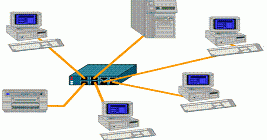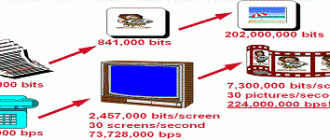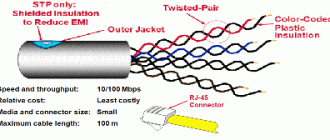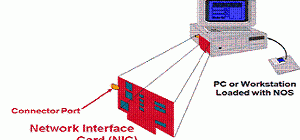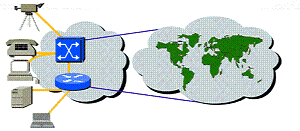Let’s now take a look at some of the devices that move traffic around the network.
The approach taken in this section will be simple. As networking technology continues to evolve, the actual differences between networking devices is beginning to blur slightly. Routers today are switching packets faster and yielding the performance of switches. Switches, on the other hand, are being designed with more intelligence and able to act more like routers. Hubs, while traditionally not intelligent in terms of the amount of software they run, are now being designed with software that allows the hub to be “intelligent” acting more like a switch.
In this section, we’ll keep these different types of product separate so that you can understand the basics. Let’s start off with the hub.
Hub
Star topology networks generally have a hub in the center of the network that connects all of the devices together using cabling. When bits hit a networking device, be they hubs, switches, or routers, the devices will strengthen the signal and then send it on its way.
A hub is simple a multiport repeater. There is usually no software to load, and no configuration required (i.e. network administrators don’t have to tell the device what to do).
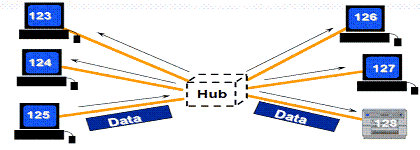
Hubs operate very much the same way as a repeater. They amplify and propagate signals received out all ports, with the exception of the port from which the data arrived.
For example in the above image, if system 125 wanted to print on the printer 128, the message would be sent to all systems on Segment 1, as well as across the hub to all systems on Segment 2. System 128 would see that the message is intended for it and would process it.
Devices on the network are constantly listening for data. When devices sense a frame of information that is addressed (and we will talk more about addressing later) for it, then it will accept that information into memory found on the network interface card (NIC) and begin processing the data.
In fairly small networks, hubs work very well. However, in large networks the limitations of hubs creates problems for network managers. In this example, Ethernet is the standard being used.
The network is also baseband, only one station can use the network at a time. If the applications and files being used on this network are large, and there are more nodes on the network, contention for bandwidth will slow the responsiveness of the network down.
Bridges

Bridges improve network throughput and operate at a more intelligent level than do hubs. A bridge is considered to be a store and forward device that uses unique hardware addresses to filter traffic that would otherwise travel from one segment to another. A bridge performs the following functions:
- Reads data frame headers and records source address/port (segment) pairs
- Reads the destination address of incoming frames and uses recorded addresses to determine the appropriate outbound port for the frame.
- Uses memory buffers to store frames during periods of heavy transmission, and forwards them when the medium is ready.
Let’s take a look at an example.
The bridge divides this Ethernet LAN into two segments in the above image, each connecting to a hub and then to a bridge port. Stations 123-125 are on segment 1 and stations 126-128 are on segment 2.
When station 124 transmits to station 125, the frame goes into the hub (who repeats it and sends it out all connected ports) and then on to the bridge. The bridge will not forward the frame because it recognizes that stations 124 and 125 are on the same segment. Only traffic between segments passes through the bridge. In this example, a data frame from station 123, 124, or 125 to any station on segment 2 would be forwarded, and so would a message from any station on segment 2 to stations on segment 1.
When one station transmits, all other stations must wait until the line is silent again before transmitting. In Ethernet, only one station can transmit at a time, or data frames will collide with each other, corrupting the data in both frames.
Bridges will listen to the network and keep track of who they are hearing. For instance, the bridge in this example will know that system 127 is on Segment 2, and that 125 is on segment 1. The bridge may even have a port (perhaps out to the Internet) where it will send all packets that it cannot identify a destination for.
Switches
Switches use bridging technology to forward traffic between ports. They provide full dedicated transmission rates between two stations that are directly connected to the switch ports. Switches also build and maintain address tables just like bridges do. These address tables are known as “content addressable memory.”
Let’s look at an example.
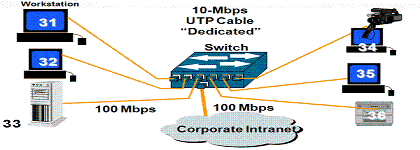
Replacing the two hubs and the bridge with an Ethernet switch provides the users with dedicated bandwidth. Each station has a full 10Mbps “pipe” to the switch. With a switch at the center of the network, combined with the 100Mbps links, users have greater access to the network.
Given the size of the files and applications on this network, additional bandwidth for access to the sever or to the corporate intranet is possible by using a switch that has both 10Mbps and 100Mbps Fast Ethernet ports. The 10Mbps links could be used to support all the desktop devices, including the printer, while the 100Mbps switch ports would be used for higher bandwidth needs.
Routers
A router has two basic functions, path determination using a variety of metrics, and forwarding packets from one network to another. Routing metrics can include load on the link between devices, delay, bandwidth, and reliability, or even hop count (i.e. the number of devices a packet must go through in order to reach its destination).
In essence, routers will do all that bridges and switches will do, plus more. Routers have the capability of looking deeper into the data frame and applying network services based on the destination IP address. Destination and Source IP addresses are a part of the network header added to a packet encapsulation at the network layer.
Summary of Lesson 1
- LANs are designed to operate within a limited geographic area
- Key LAN components are computers, NOS, NICs, hubs, and cables
- Common LAN topologies include bus, tree, star, and ring
- Common LAN/WAN devices are hubs, bridges, switches, and routers

